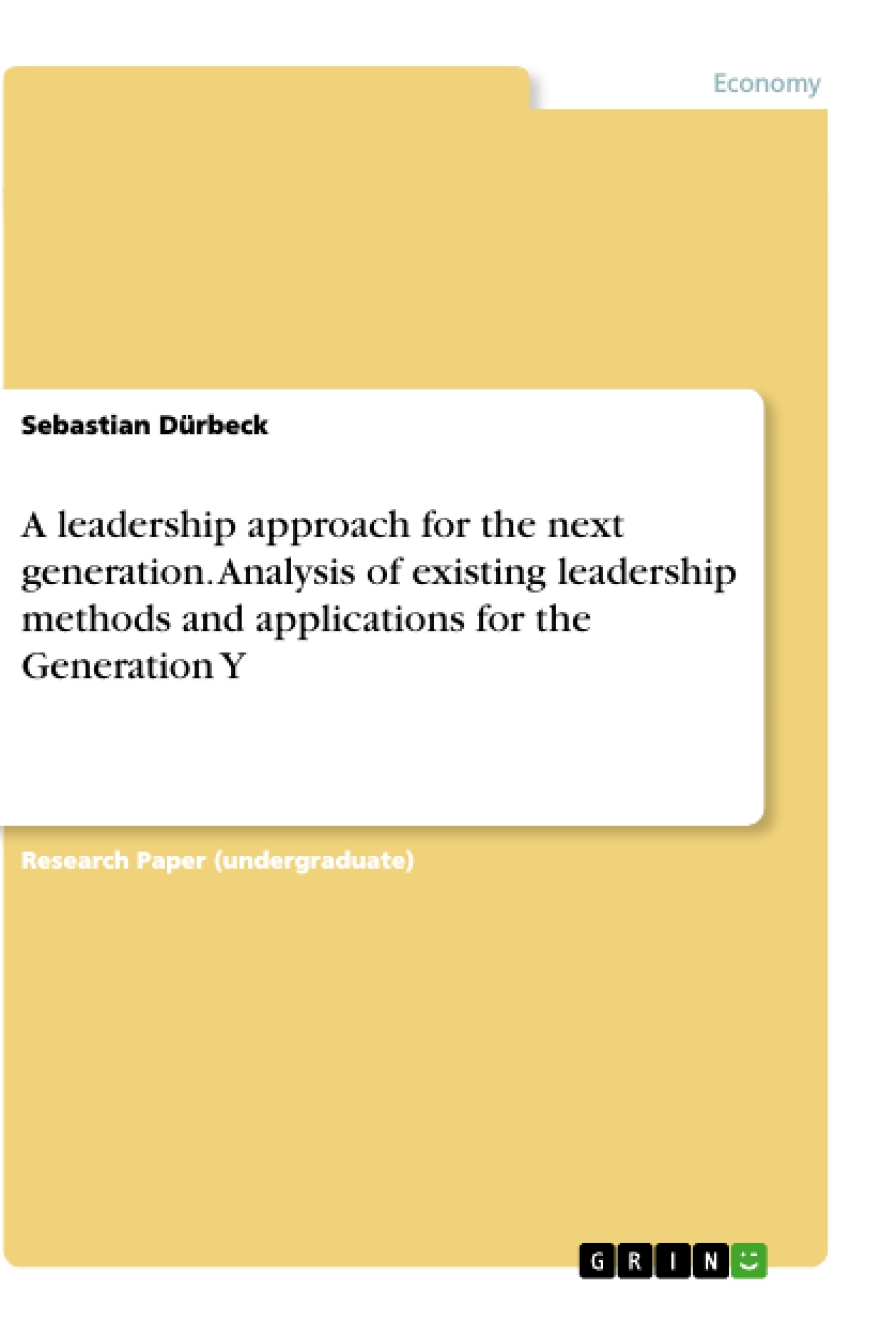This study aims to answer how the Generation Y has brought and will bring a new way of working to the companies and how the leadership methods and management organization in companies are influenced. The analysis is based on both scientific researches as well as on experiences of representatives of the Generation Y.
In chapter two the Generation Y is defined and analyzed in general, concerning characteristics and social behavior. The study is limited to the relevant factors and reasons why Millennials act like they do. The third chapter cares about the working and leadership environment of the representatives of the Generation Y and focusses on their attitude towards work and internal organizational structures. One key aspect will be their expectations for leadership, the other core area will be some selected superordinate strategies that match to their attitudes and that can be implemented in organizational structures. Chapter four discusses and evaluates a selection of existing leadership models and some new or modified approaches in matters of the demands of the Generation Y. After a short summary of the whole study in chapter five, some unconsidered topics are mentioned in the last chapter and an outlook is given.
Inhaltsverzeichnis (Table of Contents)
- Introduction
- Problem Statement
- Structure and Objectives
- Generation Y
- Disambiguation and Demarcation
- Characteristics
- Basic Impulse
- Motives
- Social Behavior
- Media
- Communication
- Working and Leadership Environment
- Attitude to Work
- Organization and Hierarchy
- Leadership Requirements
- Superordinate Strategic Tools
- Motivation 3.0
- SCARF-Model
- VIE-Model
- Tit-for-Tat Strategy
- Leadership Methods
- Behavioral Approaches
- Bottom-up Approach
- Transformational Leadership
- Dialogical Leadership
- Behavioral-Situational Leadership
- Value-based Leadership
- Meaning-oriented Leadership
- Resonant Leadership
- Servant Leadership
- Leading by Meaning
- Shared Leadership
- Further Approaches
- Magnet-for-free-Radicals Approach
- Structural-Holes Approach
- Behavioral Approaches
Zielsetzung und Themenschwerpunkte (Objectives and Key Themes)
This study aims to analyze how the Generation Y has influenced and will continue to influence the working world and how their expectations shape leadership methods and organizational structures within companies. It explores the characteristics and social behavior of Generation Y, their attitudes towards work and organizational hierarchies, and examines specific leadership models and approaches that align with their values and motives.
- Understanding the Generation Y: This includes analyzing their characteristics, social behavior, and motives, particularly within the context of work.
- Exploring the working and leadership environment: This involves analyzing their attitudes towards work, expectations for organizational structures and leadership styles, and the impact of their values on the workplace.
- Evaluating existing and emerging leadership models: This includes examining how existing leadership approaches can be adapted to accommodate Generation Y's demands, and exploring innovative leadership models that are better suited to this generation.
- Understanding the importance of intrinsic motivation: This study explores how to motivate Generation Y employees through intrinsic motivators, such as autonomy, mastery, and purpose.
- The role of emotional intelligence in leadership: This study emphasizes the importance of emotional intelligence in leadership, highlighting approaches such as resonant leadership and servant leadership, which prioritize empathy, connection, and authenticity.
Zusammenfassung der Kapitel (Chapter Summaries)
- Introduction: The chapter introduces the concept of developing employees into "fans" of a company, highlighting the importance of employer attractiveness in the context of attracting Generation Y talent. It presents the challenges and questions companies face in attracting and retaining this generation.
- Generation Y: This chapter explores the characteristics and social behavior of Generation Y, including their values, motives, and communication styles. It delves into the nuances of their behavior within the context of technology, social media, and workplace interactions.
- Working and Leadership Environment: This chapter examines Generation Y's attitude towards work, their preferences for organizational structures, and their expectations for leadership. It analyzes how their values influence the desired working environment, including factors like work-life balance, autonomy, and purpose.
- Leadership Methods: This chapter explores different leadership approaches and their effectiveness in addressing Generation Y's values and expectations. It examines behavioral, value-based, meaning-oriented, and shared leadership models, highlighting their specific strengths and potential for success.
Schlüsselwörter (Keywords)
Key terms and concepts explored in this text include: Generation Y, Millennials, leadership, employer attractiveness, motivation, organizational culture, transformational leadership, dialogical leadership, resonant leadership, servant leadership, shared leadership, value-based leadership, meaning-oriented leadership, employee engagement, and intrinsic motivation.
- Quote paper
- Sebastian Dürbeck (Author), 2016, A leadership approach for the next generation. Analysis of existing leadership methods and applications for the Generation Y, Munich, GRIN Verlag, https://www.grin.com/document/337823




